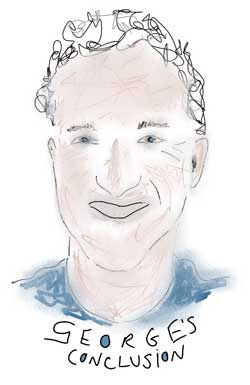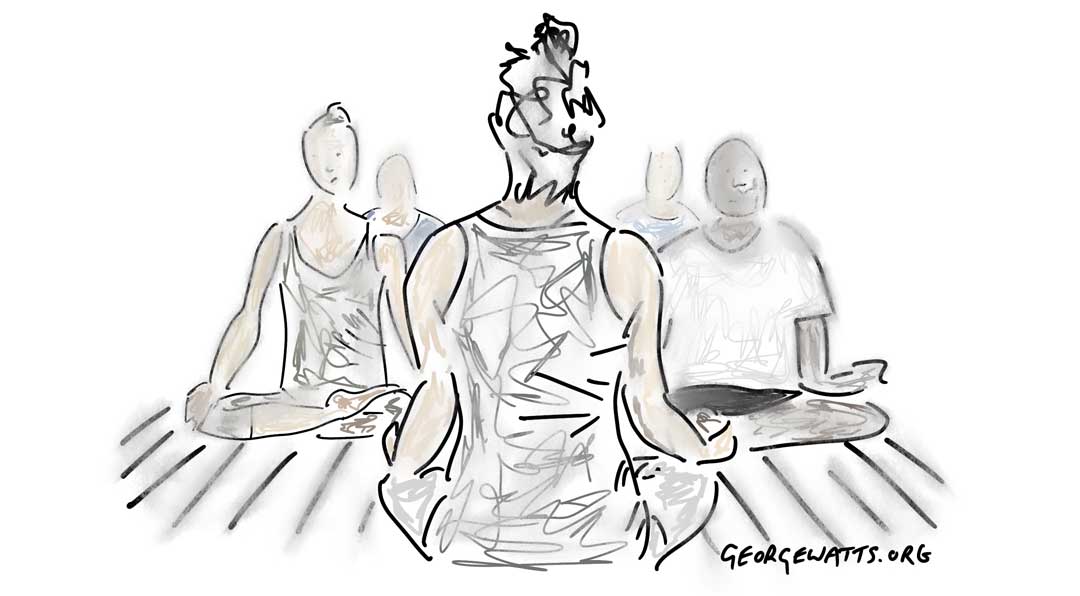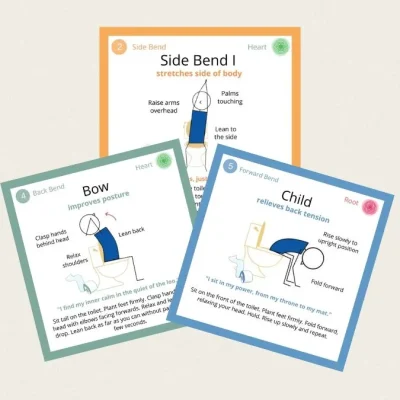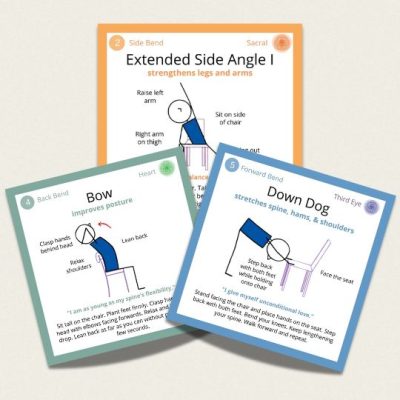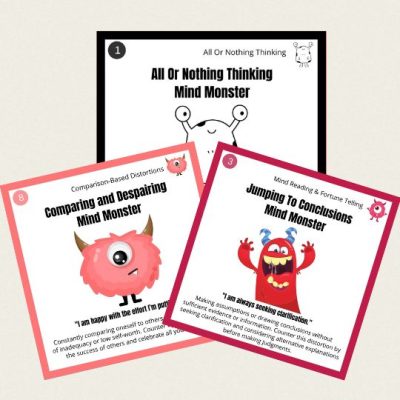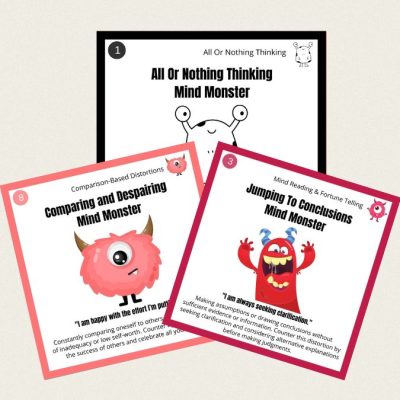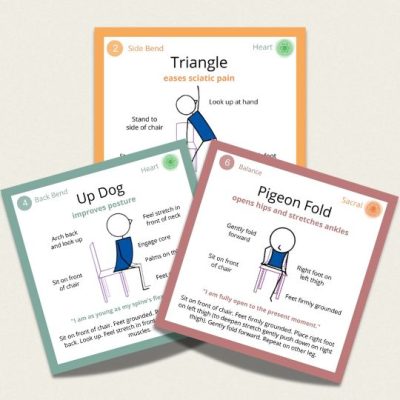29 Common Sequencing Mistakes Yoga Teachers Make: From Overlooking The Importance Of Warm-up To Not Using An Online Yoga Lesson Planner

Greetings, my lovely Yogis, Yoginis, and Yoga teachers. I’m George Watts, a BWY yoga teacher and creator of the Online Yoga Lesson Planner.
If you’re a yoga teacher, you’re about to discover the 29 most common yoga sequencing mistakes.
I’ve created 864+ yoga lesson plans over the past 12+ years. I love creating lesson plans because I’m aware of the significance that a well-crafted lesson plan has on the lives of my students.
It’s not just a piece of paper that I take into class, it’s a way of life.
For this post, I searched through 62 yoga lesson plans that I created when starting out as a teacher in 2010, but I didn’t stop there.
I then looked through 359 yoga lesson plans created by yoga teachers who use my Online Yoga Lesson Planner.
From my research, I created this free mini yoga course on how to avoid the 29 most common sequencing mistakes…
Yoga Sequencing
Mistake 1: Overlooking The Importance Of Warm-up
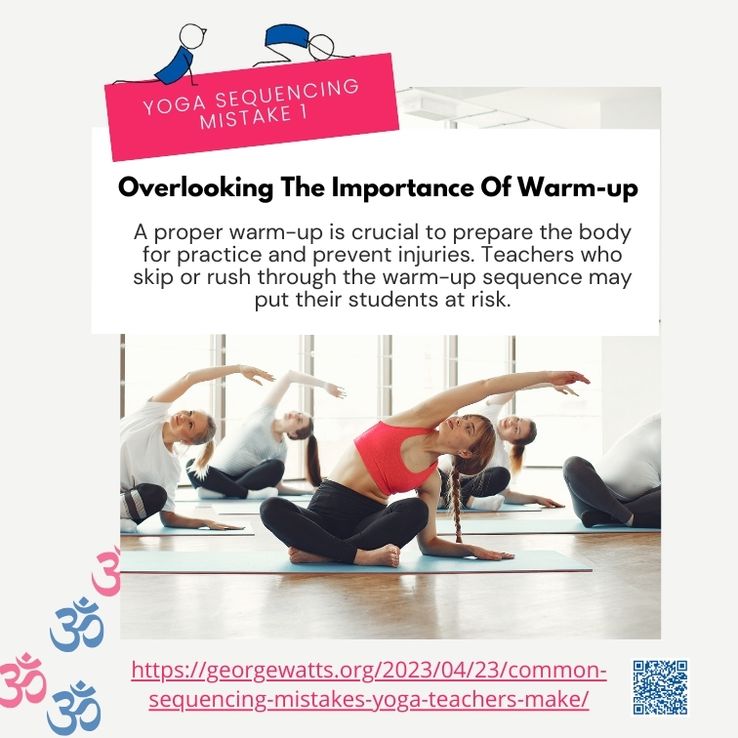
Yoga Sequencing Mistake 1: Overlooking Warm Up
A proper warm-up is crucial to prepare the body for practice and prevent injuries. Teachers who skip or rush through the warm-up sequence may put their students at risk.
After polling the 1000+ members of my Online Yoga Lesson Planner, here are 21 poses that are commonly used as warm-ups at the beginning of a yoga class (the Sun Salutations aren’t poses, but are often used at the beginning of a class):
- Cat-Cow pose
- Child’s pose
- Downward Facing Dog pose
- Sun Salutation A
- Sun Salutation B
- Sun Salutation C
- Mountain pose
- Standing Forward Bend pose
- Extended Triangle pose
- Warrior I pose
- Warrior II pose
- Extended Side Angle pose
- Plank pose
- Cobra pose
- Upward Facing Dog pose
- Low Lunge pose
- High Lunge pose
- Squat (Garland) pose
- Chair pose
- Eagle pose
- Tree pose
These poses work to gently warm up the body, increase circulation, stretch the muscles, and prepare the mind for the practice ahead. Each pose can be held for a few breaths.
Yoga Sequencing
Mistake 2: Focusing Too Much On One Area Of The Body

Yoga Sequencing Mistake 2: Focusing Too Much On One Area Of The Body
Focusing excessively on specific parts of the body like hips or shoulders and neglecting others can result in muscle imbalances and increased risk of injury.
As a yoga teacher, it is essential to create a balanced practice that targets all areas of the body, ensuring that each muscle group is adequately stretched and strengthened.
The Online Yoga Lesson Planner has 83 categories to choose from, so you’ll never make this mistake!
Yoga Sequencing
Mistake 3: Not Offering Modifications
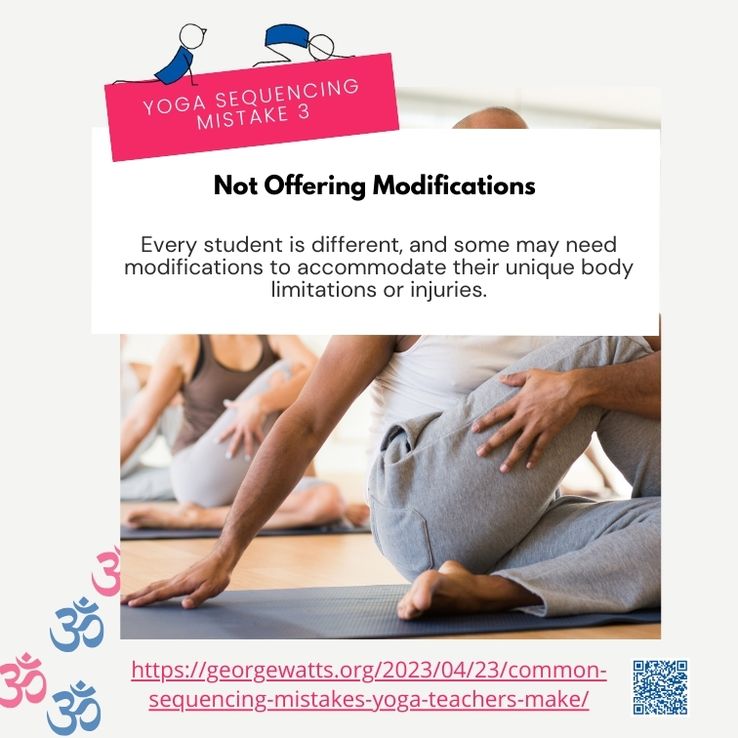
Yoga Sequencing Mistake 3: Not Offering Modifications
Every student is different, and some may need modifications to accommodate their unique body limitations or injuries.
I recommend going overboard in discovering as many modifications for a pose as you can get your Yogic hands-on.
I turn it into a game. For example, when preparing for a class, I came up with 22 Modifications for a Wrist-friendly Sun Salutations A Sequence for a student that I know has wrist pain.
I could have stopped at two or three modifications, but I kept my thinking cap on, and after 30 minutes I got to 22 of them. You may think that’s a lot of work, but it’s not really when you consider that you can use those modifications for the rest of your yoga teaching career. So, those 30 minutes of “thinking” and “researching” is a good investment of your time.
After writing down as many modifications as I can, I then visualise teaching them. I sit with my eyes closed and visualise myself giving all 22 modifications to students in my class.
And finally, I get on my yoga mat and practice the modifications over and over and over again.
The visualisation along with the repetitious practice of the modifications will plant them in your long-term memory.
The Online Yoga Lesson Planner has modifications for every pose, so you’ll never make this mistake!
Yoga Sequencing
Mistake 4: Offering Too Many Modifications
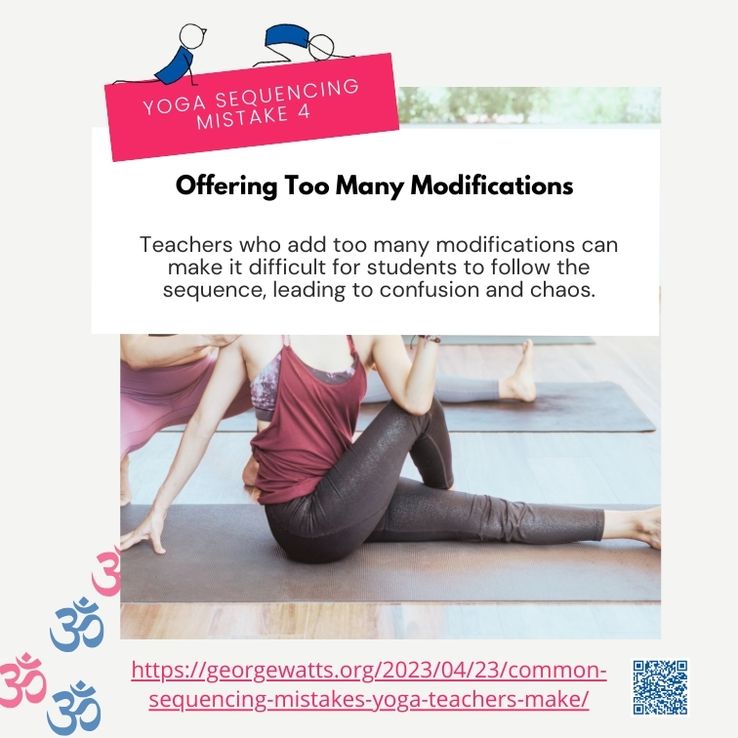
Yoga Sequencing Mistake 4: Offering Too Many Modifications
Teachers who add too many modifications can make it difficult for students to follow the sequence, leading to confusion and chaos.
Like the Three Little Bears tale, balance is key—too many or too few modifications can disrupt harmony. Hey, just in case you’ve forgotten, the Three Little Bears is a tale where Goldilocks seeks balance, rejecting options that are too extreme—too hot, cold, hard, or soft—until she finds one that’s “just right.”
Yoga Sequencing
Mistake 5: Unbalanced Lesson Plan
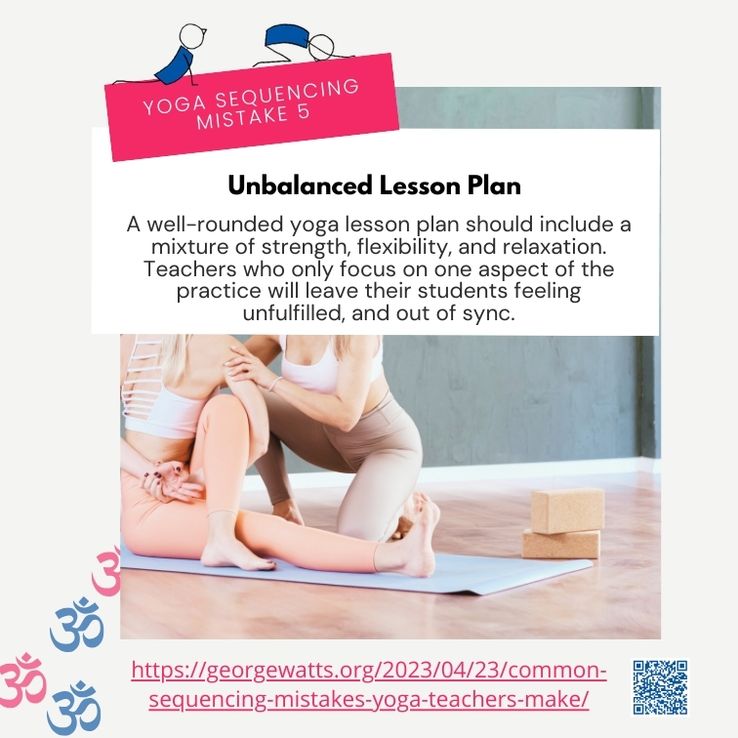
Yoga Sequencing Mistake 5: Unbalanced Lesson Plan
A well-rounded yoga lesson plan should include a mixture of strength, flexibility, and relaxation. Teachers who only focus on one aspect of the practice will leave their students feeling unfulfilled, and out of sync.
The Online Yoga Lesson Planner has 83 categories to choose from, making it easy to create balanced lesson plans.
Yoga Sequencing
Mistake 6: Not Considering Student’s Level
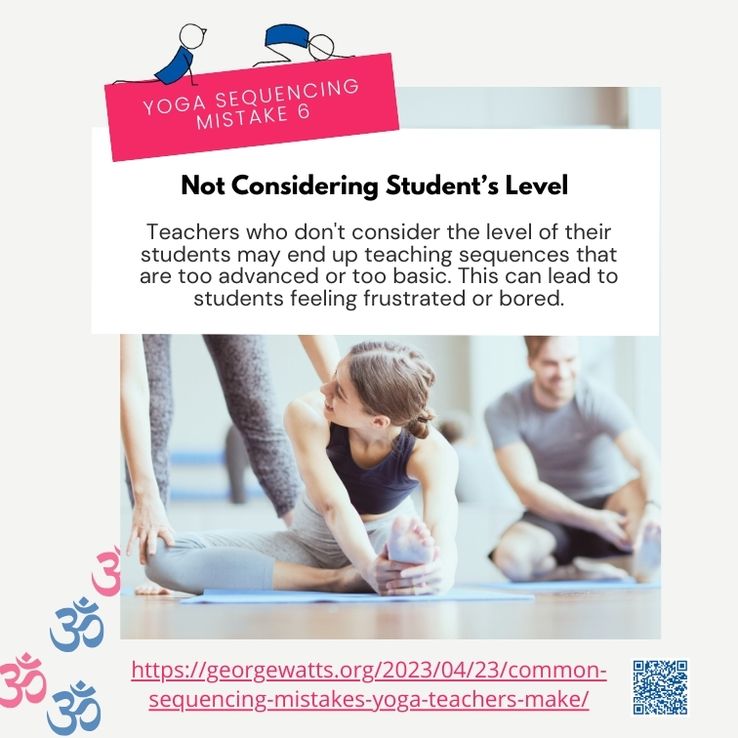
Yoga Sequencing Mistake 6: Not Considering Student Level
Teachers who don’t consider the level of their students may end up teaching sequences that are too advanced or too basic. This can lead to students feeling frustrated or bored.
Whether you’re teaching a beginner, intermediate or advanced class, the Online Yoga Lesson Planner has your back, so you’ll never make this mistake!
Yoga Sequencing
Mistake 7: Not Enough Savasana
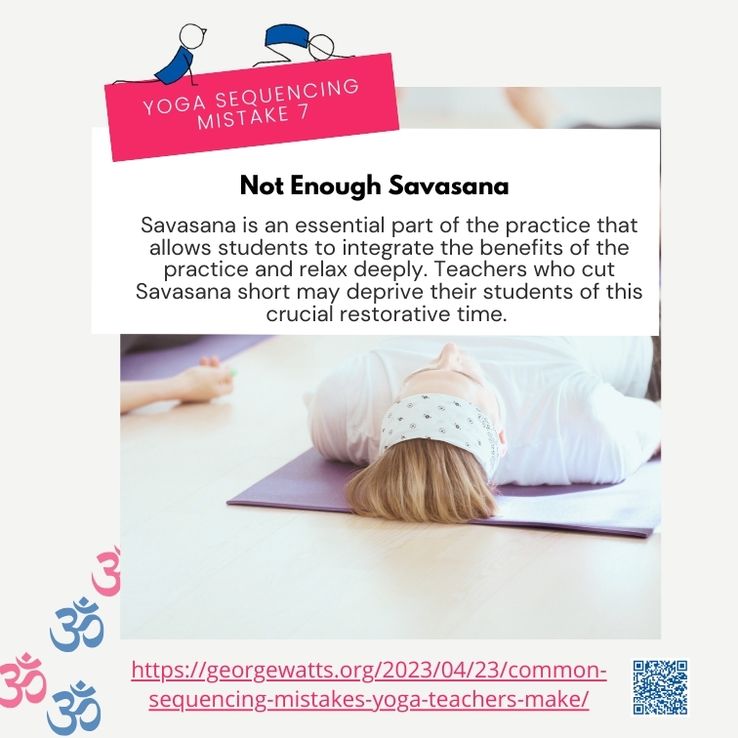
Yoga Sequencing Mistake 7: Not Enough Savasana
Savasana is an essential part of the practice that allows students to integrate the benefits of the practice and relax deeply.
Teachers who cut Savasana short may deprive their students of this crucial restorative time. Give your students at least 10 minutes in Savasana.
The Online Yoga Lesson Planner has dozens of relaxation exercises that you can use at the end of a class, including Savasana, so you’ll never make this mistake!
Yoga Sequencing
Mistake 8: Overcomplicating Sequencing
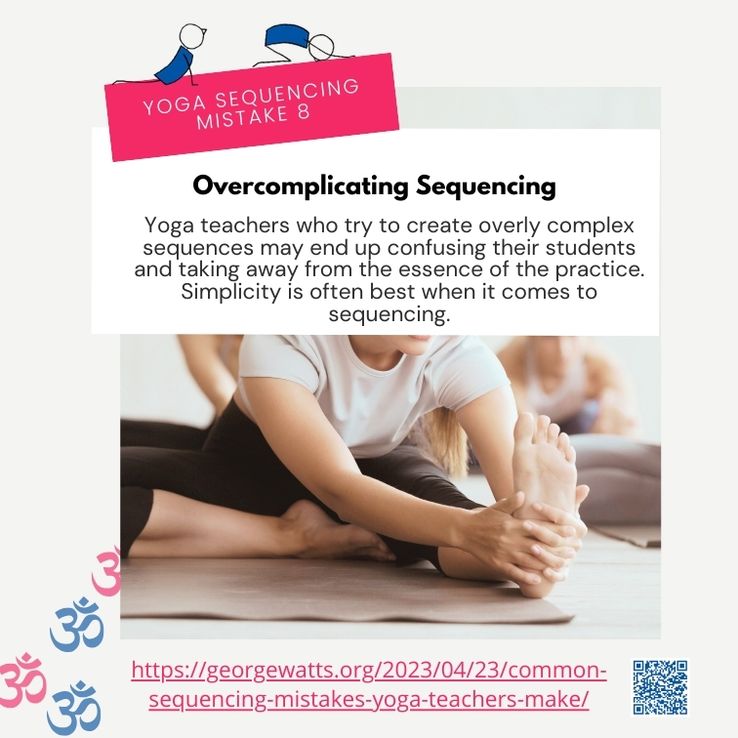
Yoga Sequencing Mistake 8: Overcomplicating Sequencing
Yoga teachers who try to create overly complex sequences may end up confusing their students and taking away from the essence of the practice. Simplicity is often best when it comes to sequencing.
The Online Yoga Lesson Planner creates lesson plans with the famous large blue stick figures. Those stick figures make it really easy to see if a sequence is overcomplicated, so that you never make this mistake!
Yoga Sequencing
Mistake 9: Too Many Body Areas
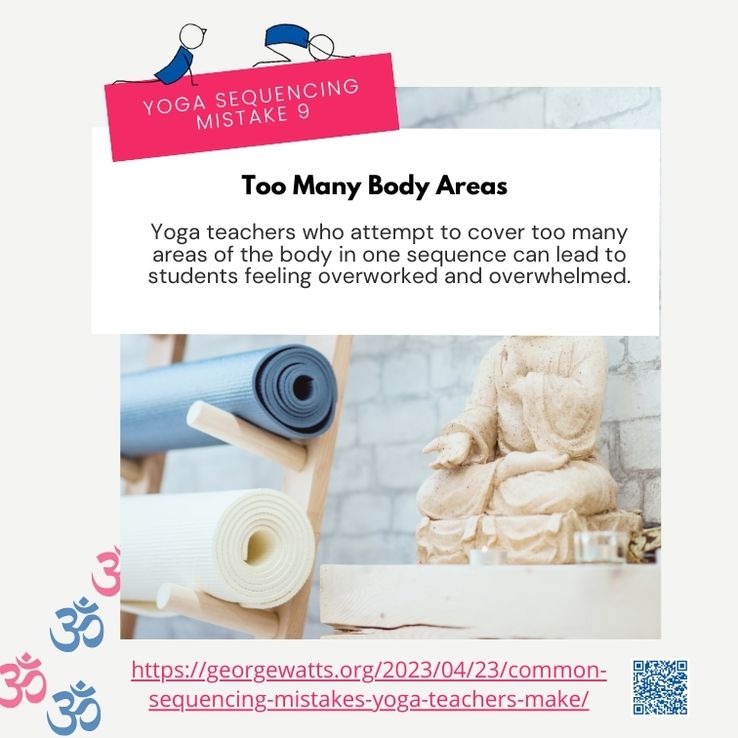
Yoga Sequencing Mistake 9: Too Many Body Areas
Yoga teachers who attempt to cover too many areas of the body in one sequence can lead to students feeling overworked and overwhelmed. It’s important to balance the practice and consider the students’ energy levels.
Yoga Sequencing
Mistake 10: Including Complicated Transitions
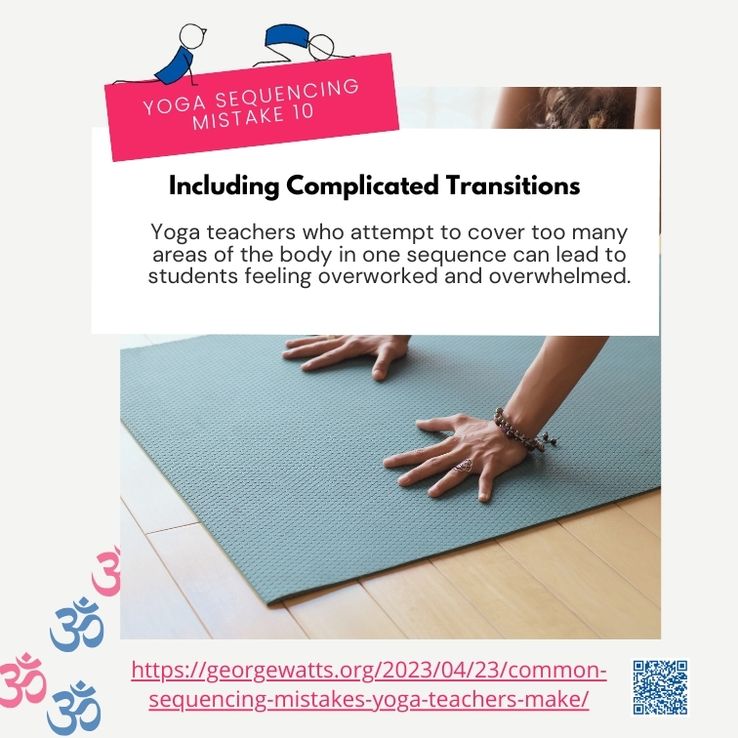
Yoga Sequencing Mistake 10: Including Complicated Transitions
Including overly complicated transitions between yoga poses can cause confusion and frustration for students, and may even lead to injury if they are not executed safely.
Smooth and rhythmic transitions are essential, and teachers should avoid sequences that require frequent changes from standing to sitting or other challenging movements that may cause discomfort or confusion. Teachers should also consider their students’ experience levels and physical abilities when designing sequences, and choose transitions that are appropriate for the class.
By creating smooth and flowing sequences, teachers can help their students stay focused and engaged in their practice, without feeling rushed or stressed.
Yoga Sequencing
Mistake 11: Rushing Through The Poses
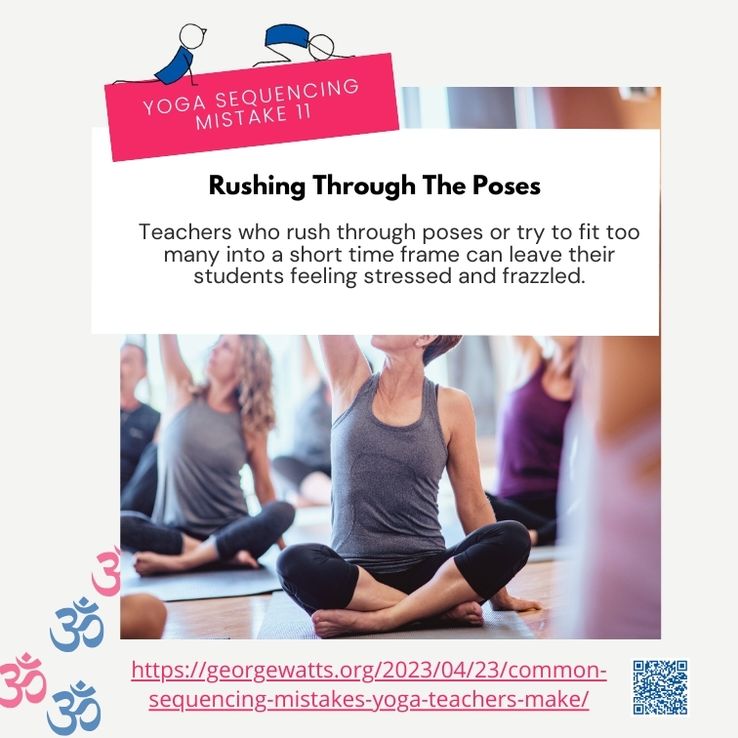
Yoga Sequencing Mistake 11: Rushing Through The Poses
When it comes to practising yoga, it’s important to allow sufficient time for each pose to let the body settle in and find its alignment.
Teachers who rush through poses or try to fit too many into a short time frame can leave their students feeling stressed and frazzled. Rather than focusing on the quality of the poses, students may end up focusing on trying to keep up with the pace of the class.
As a teacher, it’s important to balance the number of poses with the amount of time given for each one. By allowing enough time for students to breathe and find their alignment in each pose, the practice can become more meditative and mindful. This can help students to connect with their bodies, breathe deeply, and experience the full benefits of the practice.
Yoga Sequencing
Mistake 12: Lack Of Clear Intention
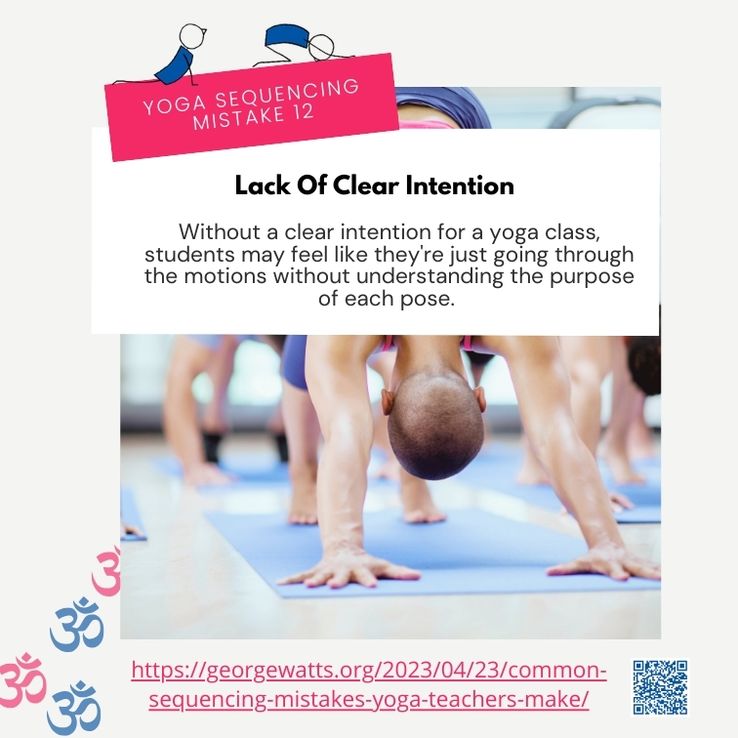
Yoga Sequencing Mistake 12: Lack Of Clear Intention
Without a clear intention or focus for a yoga class, students may feel like they’re just going through the motions without understanding the purpose of each pose. This can lead to a lack of engagement and leave students feeling unfulfilled.
Teachers need to set a clear intention or theme for each class, which can be based on a peak pose, chakra, or even a philosophical yoga concept. Having a clear intention allows teachers to guide their sequencing and cueing, giving students a better understanding of the purpose of each pose and how it fits into the larger picture of the practice.
By setting a clear intention, teachers can also create a more cohesive and meaningful experience for their students, helping them to connect with the practice on a deeper level.
With the Online Yoga Lesson Planner there is a section where you can create the aims and objectives for your class, so you’ll never make this mistake!
Yoga Sequencing
Mistake 13: Failing To Add Proper Alignment Cues
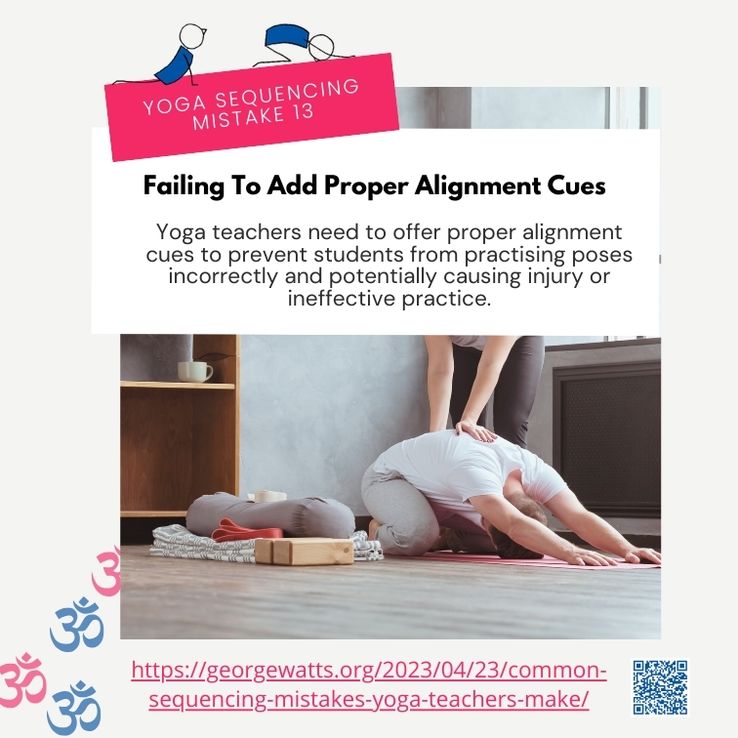
Yoga Sequencing Mistake 13: Failing To Add Proper Alignment Cues
Yoga teachers need to offer proper alignment cues to prevent students from practising poses incorrectly and potentially causing injury or ineffective practice.
Even experienced teachers can benefit from studying other teachers’ cues to improve their instruction.
In Downward Facing Dog, you might cue students to “press through the hands evenly, lifting the hips high while keeping the spine long.” In Warrior II, you could instruct, “align the front knee over the ankle and keep the back foot grounded.” When transitioning to a Forward Fold, a helpful cue might be, “hinge from the hips, not the waist, to protect the lower back.” Clear and precise alignment cues like these ensure students maintain proper form and reduce the risk of injury while fostering a deeper connection to their practice.
A yoga teacher might watch multiple videos of a particular pose and take notes on the cues used by each teacher. Or he or she may get a yoga card deck that was created by a yoga teacher, like the one I created called: The Chakra Chair Yoga Card Deck.
You could select the cues you find most effective and include them in your teaching. This approach allows for continuous learning and improvement and ensures that students receive the best possible instruction.
Proper alignment cues not only enhance the safety and effectiveness of a practice but also help students deepen their understanding of the pose and their body, leading to a more rewarding and fulfilling practice.
Each pose within Online Yoga Lesson Planner comes with alignment cues, so that you never make this mistake! But that’s not all. You can also copy lesson plans created by the 1000+ members, and learn from their alignment cues.
Yoga Sequencing
Mistake 14: Too Much Sanskrit
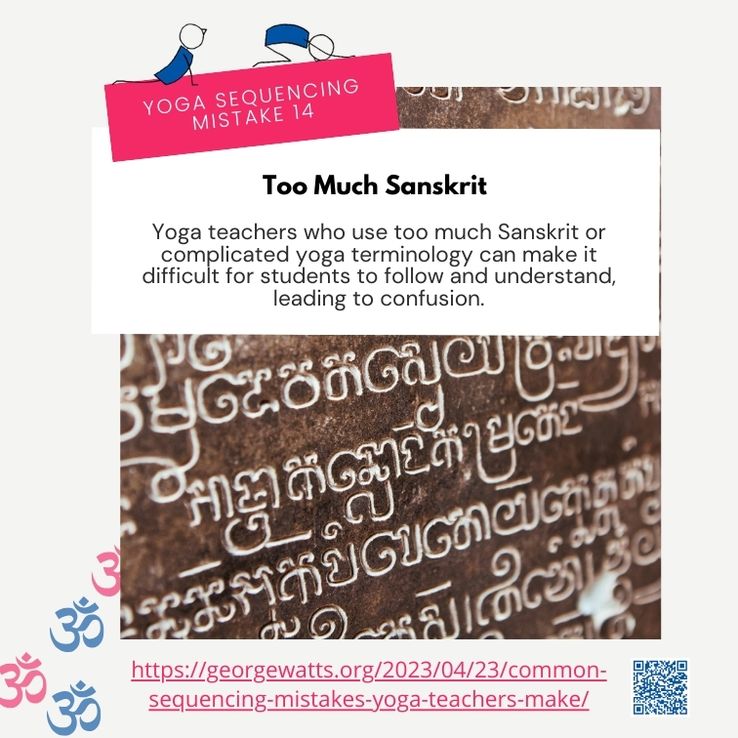
Yoga Sequencing Mistake 14: Too Much Sanskrit
Yoga teachers who use too much Sanskrit or complicated yoga terminology can make it difficult for students to follow and understand, leading to confusion.
If you’re using a lot of Sanskrit in a beginner to intermediate class you are subconsciously trying to impress your students with your vast knowledge. I used to be guilty of that, but now the only Sanskrit I use in my classes is Savasana (only because students already know it by that name) unless one of the objectives of the class is to teach Sanskrit for the poses.
If you’d like to learn how to pronounce asanas in Sanskrit, you might like this post: How to Pronounce & Memorise 101 Asanas In Sanskrit: Free Course. You also like my card deck called 101 Mini Yoga Cards: With Asana Sanskrit Pronunciations.
Each pose within Online Yoga Lesson Planner comes with the Sanskrit name, or you can choose only to see the English name of the poses.
Yoga Sequencing
Mistake 15: Teach Poses That Are Too Advanced
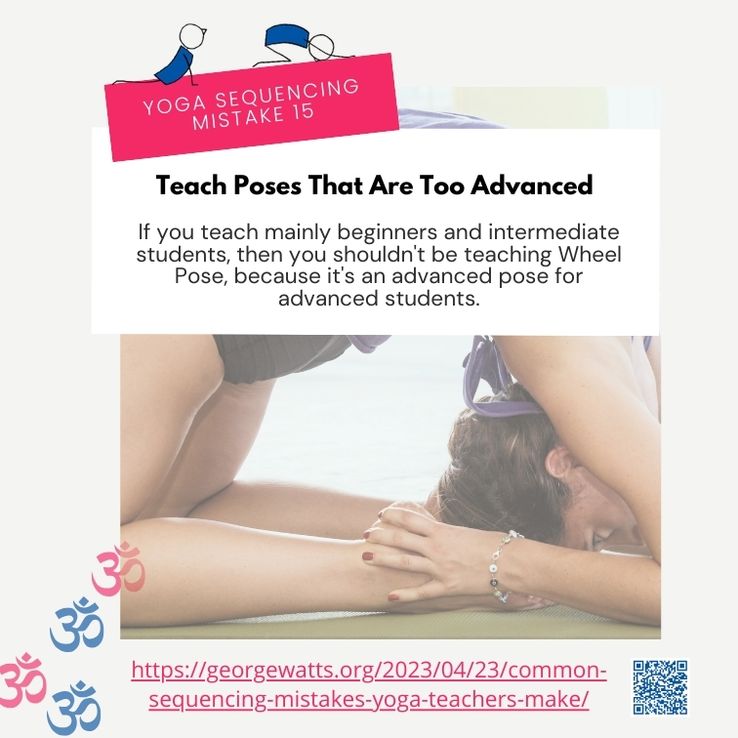
Yoga Sequencing Mistake 15: Teach Poses That Are Too Advanced
If you teach mainly beginners and intermediate students, then you shouldn’t be teaching Wheel Pose, because it’s an advanced pose for advanced students.
The truth is that you’re probably subconsciously adding complicated poses to a class to impress your students with your amazing skill when demonstrating the pose. The reality is that your students will know you’re showing off, and won’t consider that to be very yogic (unless you’re teaching an advanced class).
The Online Yoga Lesson Planner comes with 5000+ beginner, intermediate and advanced yoga poses, so that you never make this mistake!
Yoga Sequencing
Mistake 16: Always Teaching One Style Of Yoga
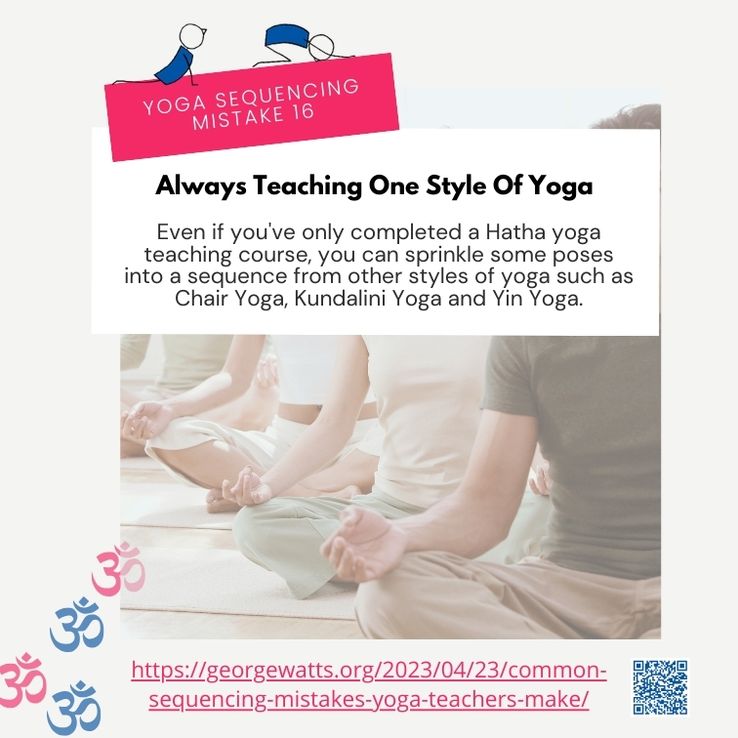
Yoga Sequencing Mistake 16: Always Teaching One Style Of Yoga
Even if you’ve only completed a Hatha yoga teaching course, you can sprinkle some poses into a sequence from other styles of yoga such as Chair Yoga, Kundalini Yoga and Yin Yoga.
To find out more about other styles of yoga, you might like this post: 17 Types Of Yoga: Which Yoga Teacher Training Is Best For You.
The Online Yoga Lesson Planner has many types of yoga to choose including Hatha Yoga, Chair Yoga, Kundalini Yoga, and Yin Yoga, so that you never make this mistake!
Yoga Sequencing
Mistake 17: Never Using The Wall
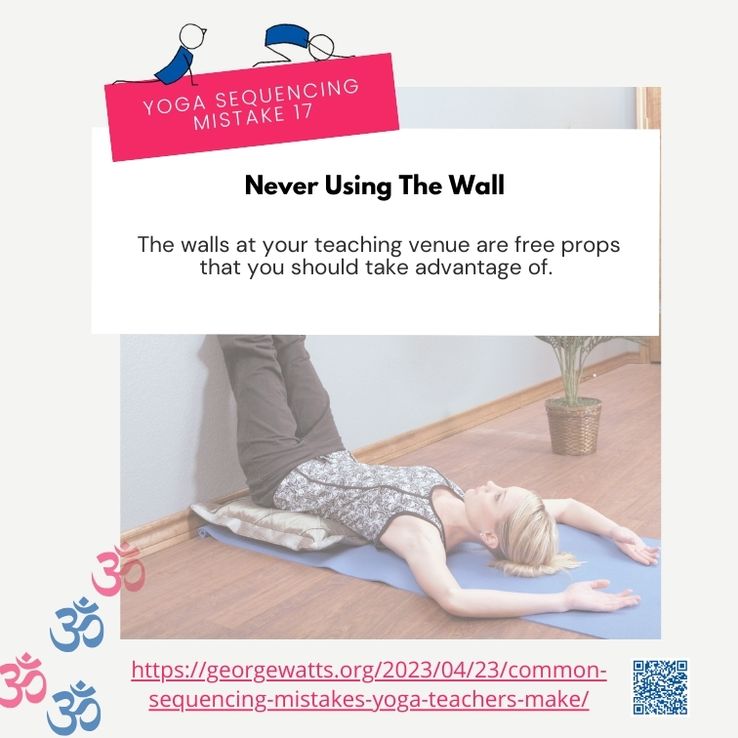
Yoga Sequencing Mistake 17: Never Using The Wall
The walls at your teaching venue are free props that you should take advantage of.
Here are 10 yoga poses with a wall as a prop:
- Legs Up Wall Pose
- Chair Pose Against A Wall
- Dancer Pose Next To A Wall
- Downward Facing Dog Against A Wall
- Handstand Against A Wall
- Shoulderstand Against A Wall
- Squat Against A Wall
- Reclined Bound Angle Against A Wall
- Mountain Pose Against A Wall
- Knees To Chest Pose Against A Wall
The Online Yoga Lesson Planner has all those “yoga poses using a wall” and many more, so that you never make this mistake!
Yoga Sequencing
Mistake 18: Never Using Chairs
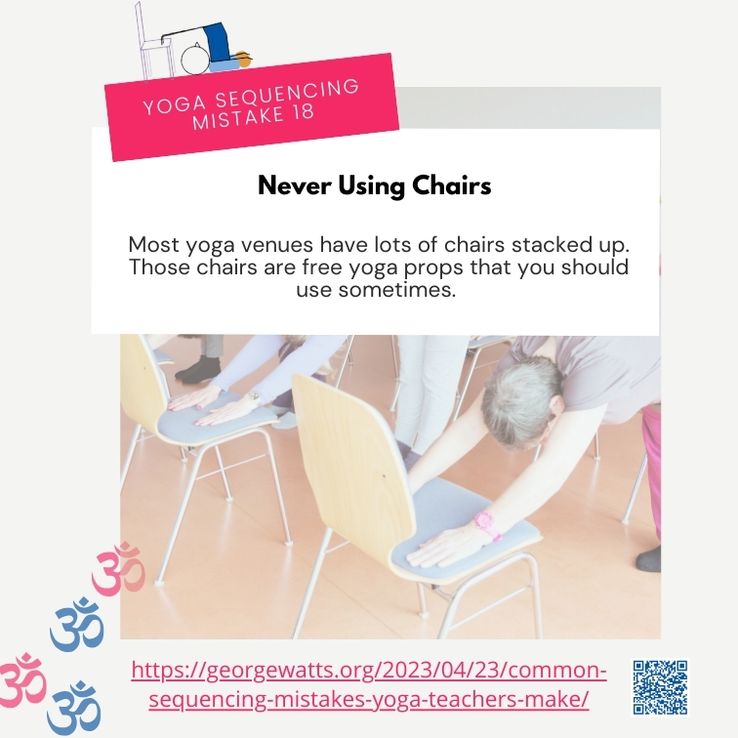
Yoga Sequencing Mistake 18: Never Using Chairs
Most yoga venues have lots of chairs stacked up.
Those chairs are free yoga props that you should use sometimes (e.g. Chair Blast Off Pose). To make my Chair Yoga classes more fun, I created these 52 Chakra Chair Yoga Cards. They are an ideal chair yoga teaching aid.
The Online Yoga Lesson Planner has 100+ chair yoga exercises that you can choose from, so that you never make this mistake!
Yoga Sequencing
Mistake 19: Neglecting To Include Counterposes
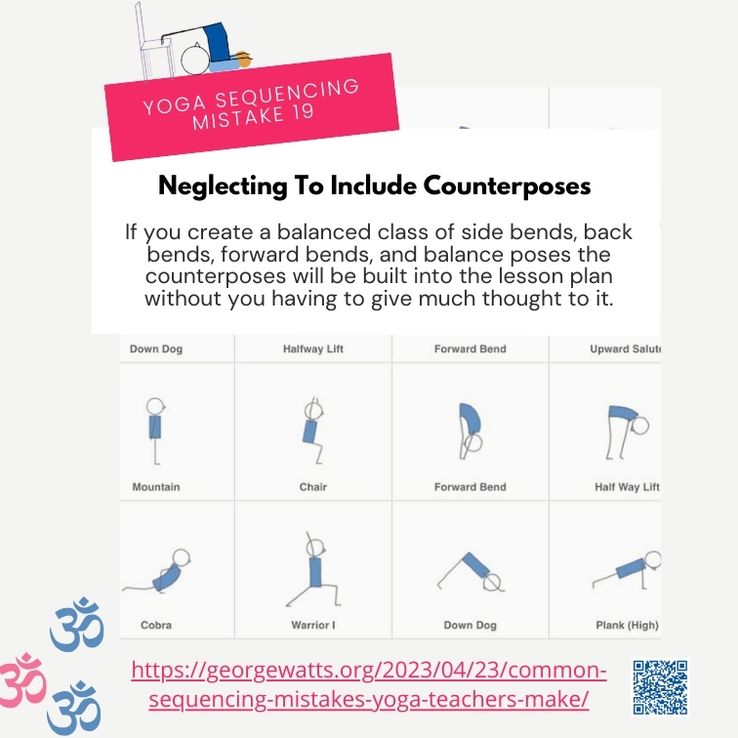
Yoga Sequencing Mistake 19: Neglecting To Include Counterposes
Yoga teachers who don’t include counterposes can leave students feeling imbalanced and potentially cause injury, but you don’t need a counter pose after every pose as that would be overkill.
If you create a balanced class of side bends, back bends, forward bends, and balance poses the counterposes will be built into the yoga lesson plan without you having to give much thought to it.
With the Online Yoga Lesson Planner you can effortlessly create balanced lesson plans with side bends, back bends, forward bends, and balance poses, so that you never make this mistake!
Yoga Sequencing
Mistake 20: Focusing Too Much On Alignment
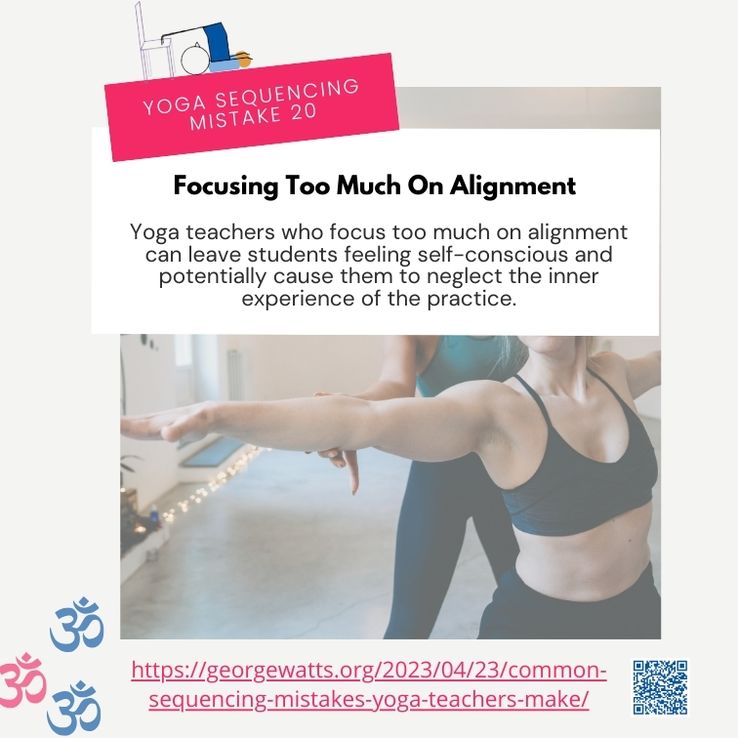
Yoga Sequencing Mistake 20: Focusing Too Much On Alignment
Yoga teachers who focus too much on alignment can leave students feeling self-conscious and potentially cause them to neglect the inner experience of the practice.
There is a sweet spot – not too much alignment and not too little. You’ll know when you’ve got it right because you’ll notice more smiles in your class.
Hey, if you want a fun way to remember Downward Facing Dog pose alignment, you might like my Yoga Assist Flashcards: Downward Facing Dog Edition.
Yoga Sequencing
Mistake 21: Not Creating A Gradual Progression
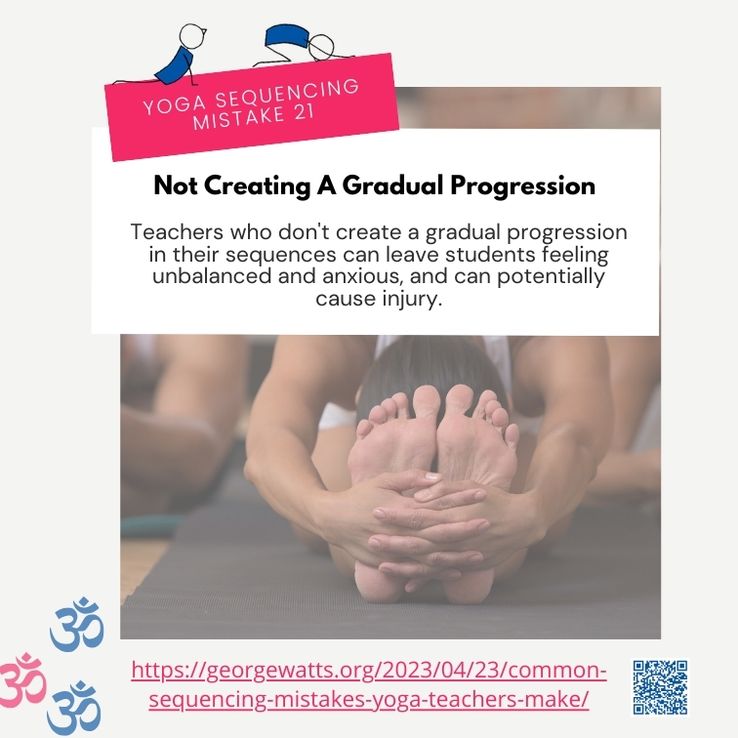
Yoga Sequencing Mistake 21: Not Creating A Gradual Progression
Teachers who don’t create a gradual progression in their sequences can leave students feeling unbalanced and anxious, and can potentially cause injury.
When you use the Online Yoga Lesson Planner, creating yoga lesson plans with a gradual progression is easy.
Yoga Sequencing
Mistake 22: Using Music
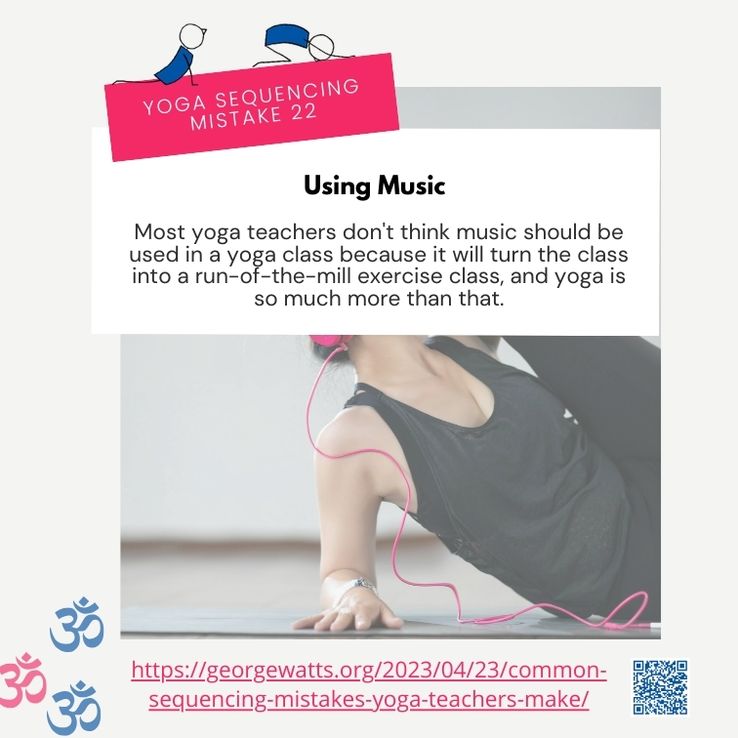
Yoga Sequencing Mistake 22: Using Music
Most yoga teachers don’t think music should be used in a yoga class because it will turn the class into a run-of-the-mill exercise class, and yoga is so much more than that.
If, however, you feel compelled to add music use soft, background music with no lyrics. One of the bonuses within the Online Yoga Lesson Planner is royalty free background music (with no lyrics).
Yoga Sequencing
Mistake 23: Overusing Props
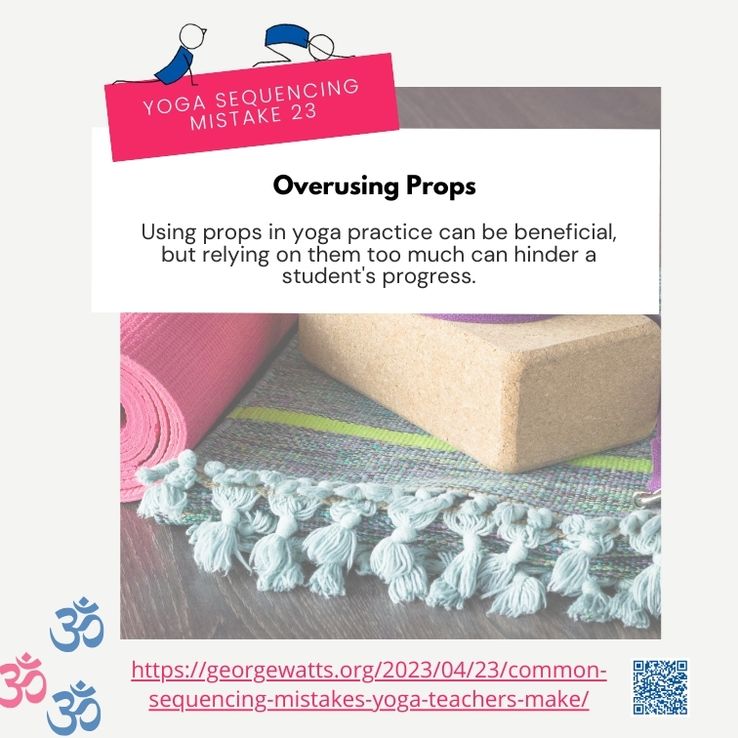
Yoga Sequencing Mistake 23: Overusing Props
Using props in yoga practice can be beneficial, but relying on them too much can hinder a student’s progress.
When yoga teachers overuse props, it can create a dependency on them, which can limit a student’s ability to develop strength, balance, and flexibility.
However, not using props at all can also be problematic for some students, who may struggle with certain poses due to physical limitations. Therefore, finding a balance between using props appropriately and encouraging students to work on building their strength and flexibility is essential.
As a teacher, it’s important to assess each student’s individual needs and offer modifications that will help them progress in their practice while avoiding excessive reliance on props. By doing so, students can develop a deeper understanding of their bodies and build a strong foundation for their yoga practice.
Yoga Sequencing
Mistake 24: Ignoring The Breath
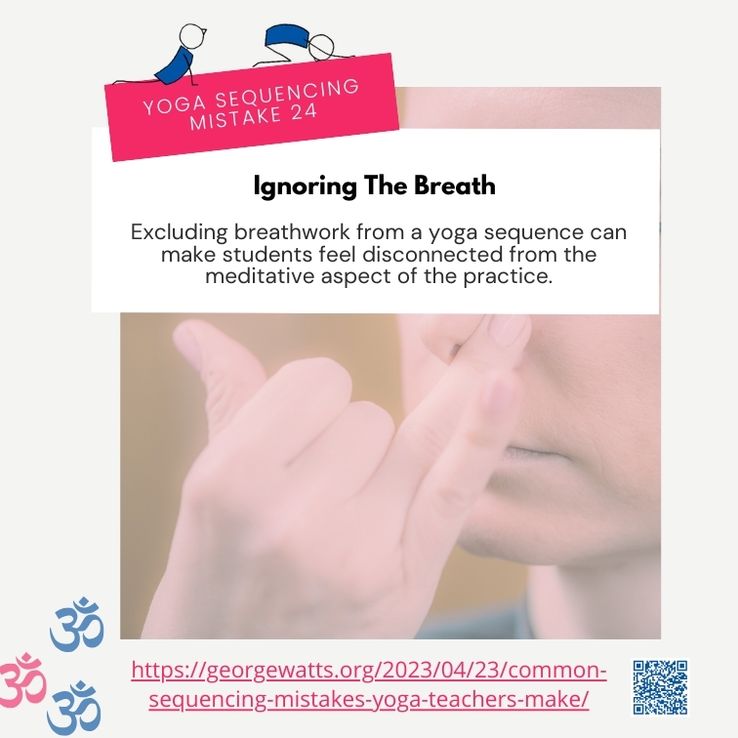
Yoga Sequencing Mistake 24: Ignoring The Breath
Excluding breathwork from a yoga sequence can make students feel disconnected from the meditative aspect of the practice.
Yoga is incomplete without incorporating breath awareness. Without mindful attention to the breath, yoga poses can become generic exercises lacking the holistic benefits of the practice.
Yoga teachers need to emphasise the importance of breathwork to create a comprehensive and meaningful yoga experience for their students.
Yoga teachers use three main techniques to get their students to focus on “the breath” during a class:
Focus On The Breath Technique 1: Start
Start the class with a breathing exercise or pranayama, which helps to bring awareness to the breath.
Focus On The Breath Technique 2: Match
During the practice, teachers may also cue the students to breathe deeply and to match the movements with the breath.
Focus On The Breath Technique 3: Cues
Teachers may also use verbal cues to encourage the students to focus on the breath, such as “breathe deeply,” “inhale,” “exhale,” or “let your breath guide you.”
Here are 20 ways to guide students to focus on their breath during a yoga class:
- “Take a deep breath in and out.”
- “Draw a long inhale through the nose and exhale through the mouth.”
- “Inhale and expand the chest, exhale and release the tension.”
- “Breathe in, breathe out, let it go.”
- “Inhale deeply and let the breath carry you into the pose.”
- “Exhale with a sigh and release any stress or tension.”
- “Breathe into the belly, expanding on the inhale and releasing on the exhale.”
- “Take a few deep breaths, filling up the lungs and emptying them.”
- “Allow the breath to be slow and steady, like ocean waves.”
- “Breathe through any discomfort or challenges in the pose.”
- “Inhale and lift, exhale and deepen the stretch.”
- “Breathe into the back body, expanding the ribcage with each inhale.”
- “Exhale with sound.”
- “Inhale and visualise the breath as a healing energy.”
- “Exhale and release any negative thoughts or emotions.”
- “Breathe in gratitude, exhale negativity.”
- “Inhale and find length, exhale and release tension.”
- “Breathe into any areas of tightness or tension in the body.”
- “Exhale and let go of any distractions or worries.”
- “Inhale and create space, exhale and let go of what no longer serves you.”
If you like breathwork, you’ll love my Pranayama Card Deck.
The Online Yoga Lesson Planner has dozens of pranayama exercises to choose from.
Yoga Sequencing
Mistake 25: Not Offering Enough Adjustments
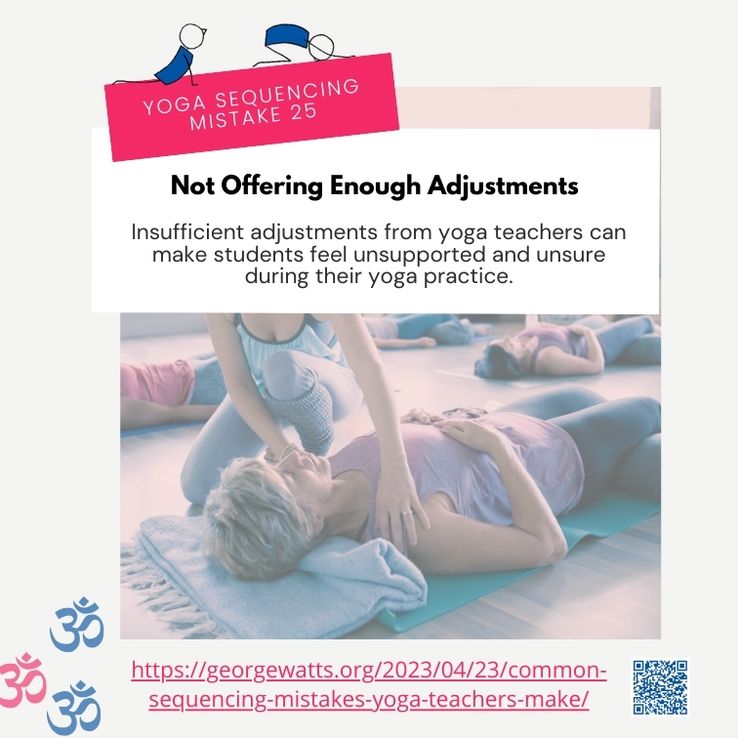
Yoga Sequencing Mistake 25: Not Offering Enough Adjustments
Insufficient adjustments from yoga teachers can make students feel unsupported and unsure during their yoga practice.
Instructors must provide adjustments and guidance to help students deepen their practice and prevent injury. While teaching a class, instructors should aim to offer adjustments whenever necessary, rather than solely demonstrating poses. This creates a supportive and beneficial environment for students.
If you want to make learning “yoga adjustments” fun, you might like my Yoga Assist Flashcards: Downward Facing Dog Edition.
Yoga Sequencing
Mistake 26: Failing To Create A Safe & Comfortable Space
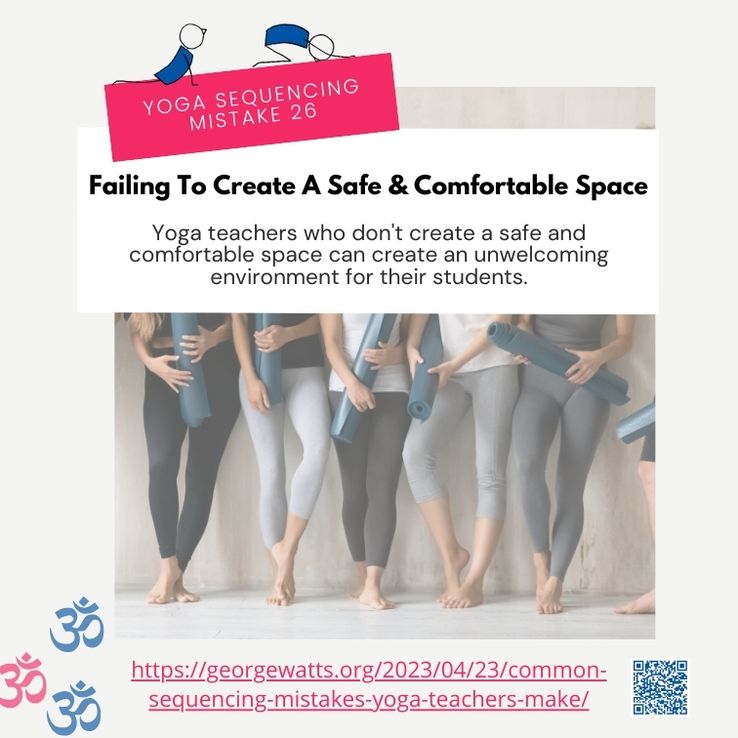
Yoga Sequencing Mistake 26: Failing To Create A Safe And Comfortable Space
Yoga teachers who don’t create a safe and comfortable space can create an unwelcoming environment for their students.
For a welcoming and safe yoga environment, prioritise cleanliness and decor by using soft lighting, calming colours, and natural elements. Providing high-quality yoga equipment, greeting your students, and encouraging questions foster open communication.
Additionally, avoid language or actions that exclude any group and prioritise safety by keeping the space hazard-free and informing students of potential risks.
Lastly, create an environment of mutual respect and kindness to encourage self-respect and respect for others.
Here are 10 ways to create an environment of respect & kindness:
- Greet each student warmly by name as they enter the class.
- Set the tone with a short intention focused on kindness and connection.
- Encourage students to listen to their bodies and honour their limits.
- Use inclusive language that celebrates diversity and individuality (e.g. “Feel free to explore any variation of the pose that feels right for your body today.“)
- Remind students to focus on their own practice instead of comparing themselves to others.
- Demonstrate patience and offer modifications to meet all abilities with respect.
- Create a safe space by keeping the classroom free from judgment.
- Practice active listening when students share feedback or ask questions (e.g. “It sounds like you’re feeling uncertain about the pose. Would you like me to offer a modification?“)
- Lead by example by embodying compassion, humility, and gratitude in your teaching.
- End class with a moment of gratitude for the shared practice and mutual respect.
Yoga Sequencing
Mistake 27: Not Having A Sequencing Formula
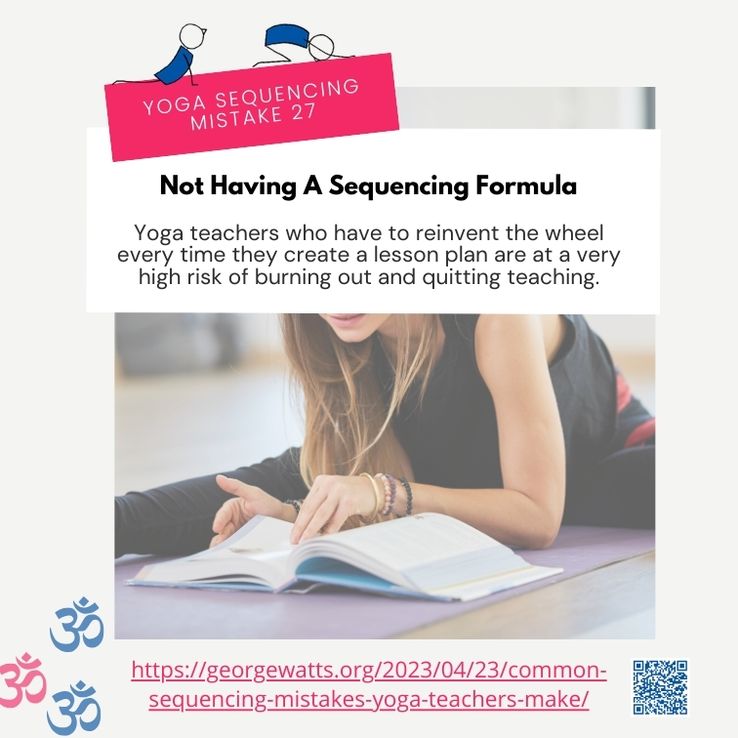
Yoga Sequencing Mistake 27: Not Having A Sequencing Formula
Yoga teachers who have to reinvent the wheel every time they create a lesson plan are at a very high risk of burning out and quitting teaching.
It’s important to have a sequencing formula that you stick to most of the time. With the Online Yoga Lesson Planner, you can input your sequencing formula and then click a button to create a yoga lesson plan, and then edit the plan as much as you like.
Within my Chakra Chair Yoga Card Deck, I included this colour-coded sequencing formula:
- Red (warm-ups)
- Orange (side bends)
- Yellow (twists)
- Green (backbends)
- Blue (forward bends)
- Brown (balance poses)
- Pink (pranayama)
Yoga Sequencing
Mistake 28: Failing To Build Up To Peak Pose Without Preparation
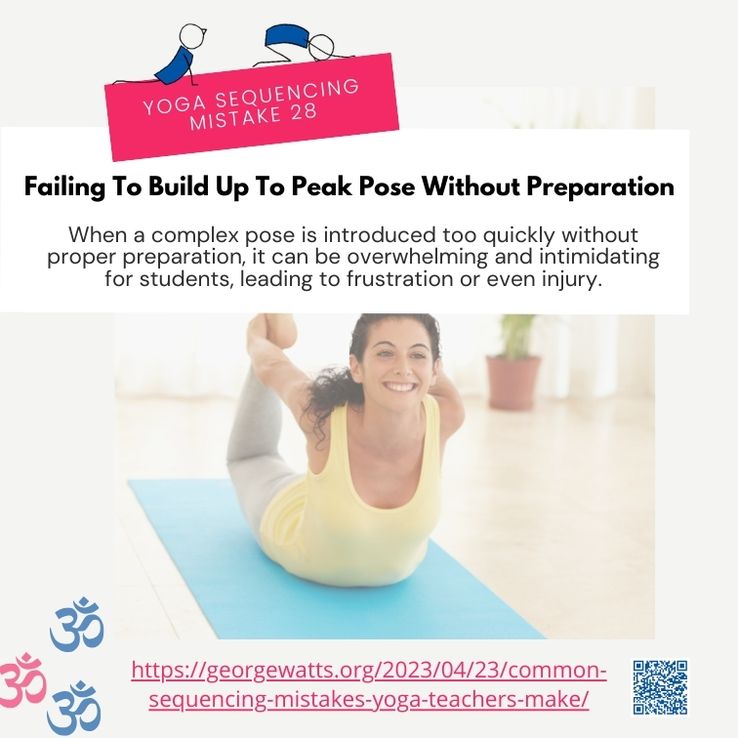
Yoga Sequencing Mistake 28: Failing To Build Up To Peak Pose Without Preparation
When a complex pose is introduced too quickly without proper preparation, it can be overwhelming and intimidating for students, leading to frustration or even injury.
For example, attempting a headstand without first building up the strength and alignment in the shoulders and core can be dangerous and ineffective.
To avoid this mistake, it’s important to include preparatory poses that help to build strength, flexibility, and proper alignment. These preparatory poses should be accessible to all levels of students and gradually build towards the more complex pose.
For example, here are five preparatory poses for Bow Pose:
- Cobra Pose: Strengthens the back and opens the chest, preparing for the backbend.
- Locust Pose: Builds back strength and warms up the spine.
- Bridge Pose: Opens the hip flexors and chest while strengthening the back.
- Cat-Cow Pose: Loosens the spine and warms up the back for deeper backbends.
- Child’s Pose: Stretches the lower back and provides a gentle counterpose to prepare the body.
You’ve guessed it. You can use the Online Yoga Lesson Planner to quickly and easily find preparatory poses.
Yoga Sequencing
Mistake 29: Not Using An Online Yoga Lesson Planner
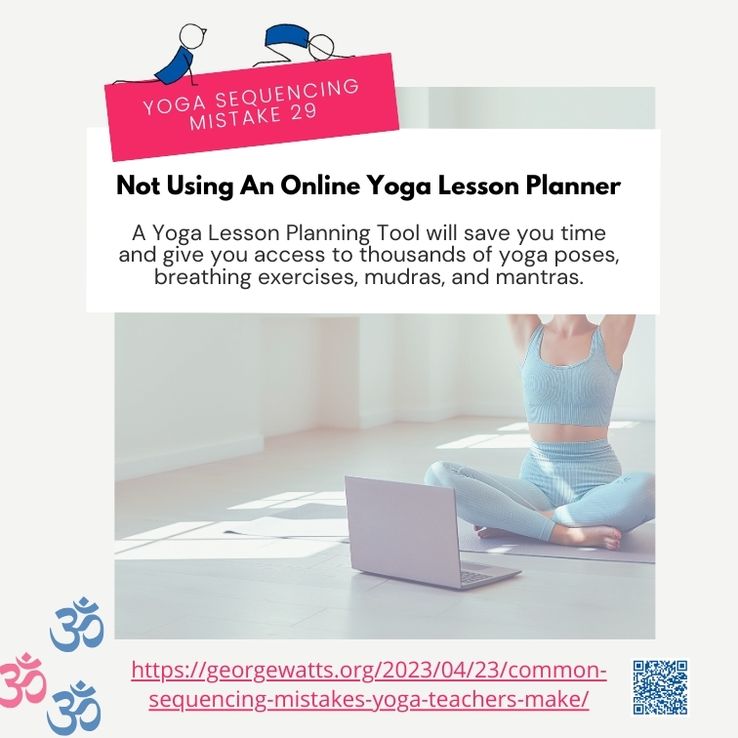
Yoga Sequencing Mistake 29: Not Using My Online Yoga Lesson Planner
Hmmm, okay, you got me!
Mistake number “29” was a bit of a self-serving one for me to add to the list. I do, however, believe that it is a mistake not to use a yoga lesson planning tool like my Online Yoga Lesson Planner.
A Yoga Lesson Planning Tool will save you time and give you access to thousands of yoga poses, breathing exercises, mudras, and mantras. You can draw yoga poses on paper, and use a Yoga Lesson Planning Tool – it’s not a case of needing to choose one method over the other.
The Complete List Of 29 Common Yoga Sequencing Mistakes: Free Infographic That You Can Download Or Bookmark
To view the full list of 29 common yoga sequencing mistakes, I’ve created an infographic that you can download (or bookmark this post for easy access).
Sequencing Mistake Infographic:

Next up, is my conclusion.
George’s Conclusion
In conclusion, sequencing in yoga is a responsibility that should not be taken lightly by a teacher.
It requires intention, attention, and compassion towards the individual needs and abilities of each student.
By being aware of common sequencing mistakes, teachers can strive to avoid them and create safe and effective classes for their students. Although avoiding all mistakes may not always be possible, being familiar with these mistakes can help teachers recognise and correct them quickly.
With dedication, practice, and a commitment to ongoing learning, teachers can develop strong sequencing skills and provide their students with a transformative and fulfilling yoga practice.
Hey, you might like this article I wrote called: 21 Yoga Poses For Your Spine:101 Ways To Improve Spinal Health.
And oh yes, I almost forgot…
My free Yoga Pose Directory has over 3000 yoga poses. So, as a yoga teacher, you’ve got instant access to lots of new poses, pranayama, mudras, meditations, mantras, and guided relaxations.
If you like creating yoga class themes, like this one, you’ll want to look at my blog post 101 Perfect Poses For A Peak Pose-Themed Yoga Lesson Plan.
If you want to streamline your yoga lesson planning process, check out my Online Yoga Lesson Planner.
And if you’ve read down here, you might as well get your paws on 37 of my free Yoga lesson plans.
Get Your Yogic Hands On 37 Of My Free Yoga Lesson Plans
Below are 37 free downloadable yoga lesson plans that I’ve created for my yoga classes using the Online Yoga Lesson Planner. Feel free to use them for your yoga classes, or as inspiration to come up with your yoga class themes.
Become A Peaceful Warrior Yoga Lesson Plan
Caterpillar To Butterfly Yoga Lesson Plan
How Heavy Is This Glass Of Water Yoga Lesson Plan
Surrender To Slowness Yoga Lesson Plan
You Don’t Need Permission To Shine: Just Show Up, Shine & Be Yourself
Abiciously Delicious Core Yoga Lesson Plan
Chair Yoga For Seniors Lesson Plan
Sun Salutations Chair Yoga Lesson Plan
Sun Salutations A Yoga Lesson Plan
Sun Salutations B Yoga Lesson Plan
Sun Salutations C Yoga Lesson Plan
Camel Peak Pose Yoga Lesson Plan
Downward Facing Dog Pose Variations Lesson Plan
Plank Peak Pose Yoga Lesson Plan
Revolved Poses Yoga Lesson Plan
Twists-Themed Yoga Lesson Plan: 41 Twist Poses To Whip Your Student’s Cores Into Shape
Yoga Therapy: Arthritic Spine Yoga Lesson Plan
Yoga Therapy: Asthma Yoga Lesson Plan
Yoga Therapy: Hips Yoga Lesson Plan
Yoga Therapy: Opening Upper Back, Neck & Shoulders Yoga Lesson Plan
Yoga Therapy: Restorative Yoga Lesson Plan


